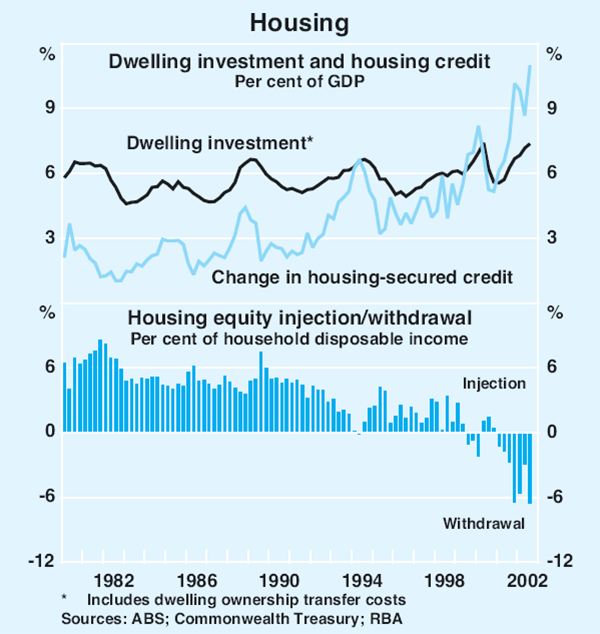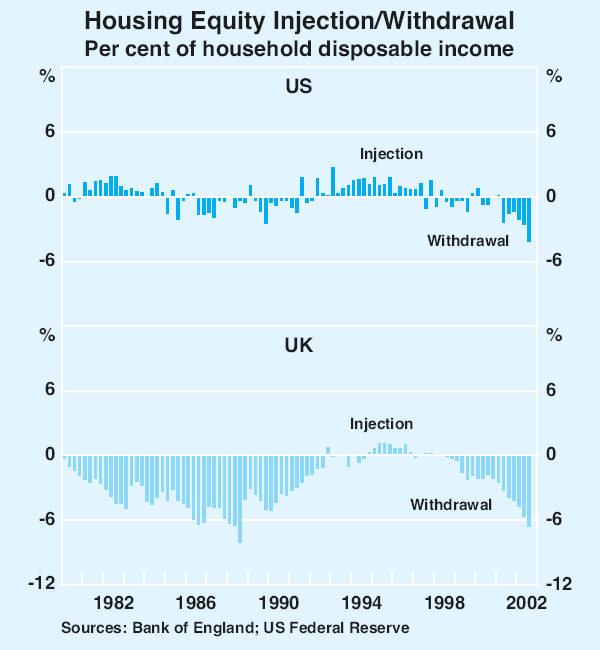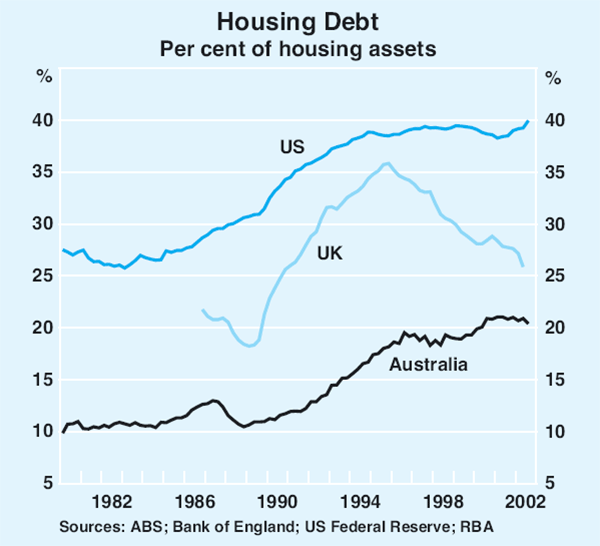Bulletin – February 2003 Housing Equity Withdrawal
- Download 436KB
The increase in housing prices in recent years has contributed to rising household wealth and has helped to underpin continued strength in consumption spending. One important aspect of this process is that rising housing prices, combined with other factors such as lower interest rates and financial innovation, have increased the capacity of households to borrow. A feature of the past few years has been that the increase in borrowing secured against housing has exceeded net new spending on housing assets. This means that households, in aggregate, have been extracting some of their equity in the housing stock to release funds for other purposes. This process of housing equity withdrawal has also been observed in the US and the UK over the past few years, and has been cited as a factor contributing to the growth of consumer spending in those countries.
Defining Housing Equity Withdrawal
Housing equity withdrawal refers to the net cash flow generated by the household sector from transactions in housing assets and mortgage debt. If the household sector in aggregate increases its mortgage debt by more than its net spending on housing assets, housing equity withdrawal is said to have taken place. This means that housing-related transactions have generated a net positive cash flow for households which is available for other uses. The reverse situation of housing equity injection occurs when net new mortgage borrowing is less than new spending on housing assets, so that housing-related transactions are a net absorber of cash flow from the household sector. As discussed below, the latter situation was the one that typically prevailed until a few years ago.[1]
It should be noted that the concept of housing equity withdrawal/injection discussed here is a measure of cash flow and therefore is separate from changes in the equity of households in housing caused by changes in the valuation of the housing stock. It is quite conceivable, indeed likely, that housing equity withdrawals can co-exist with rising overall equity in houses. This is because households may extract only part of the rise in home values by increased borrowing.
Transactions in existing properties do not affect the calculation of housing equity withdrawal/injection, except in so far as the equity position of the seller may be different from that of the buyer. For example, if a deceased estate were purchased by a first-home buyer, it is likely that there would be housing equity withdrawal as the deceased estate is likely to have had more equity in the house than the first-home buyer. As discussed in more detail below, demographic shifts can therefore influence housing equity withdrawal/injection calculations, though the impact is likely to be gradual.
At any point in time, the household sector will comprise a range of very different household types, some of which will be injecting housing equity and some withdrawing it. There are a number of ways in which individual households can vary their housing equity, some examples of which are summarised below.
Methods of withdrawing housing equity
- Trading down: a seller moves to a cheaper property, but reduces the mortgage by less. The simplest example would be a retiree in a fully-owned home who trades down and uses some of the proceeds to finance retirement.
- When moving to a more expensive home, an owner-occupier increases the mortgage by more than the difference in the prices of the old and new home.
- Last-time sales: a seller does not buy a new property with the proceeds from the sale (e.g. a deceased estate, where the value of the housing equity is distributed to the beneficiaries of the estate).
- Home-equity redraw or second mortgage: a home-owner increases the mortgage on an existing property, but does not use the funds to improve the property or buy another property.
Methods of injecting housing equity
- First-time buyers: the saved deposit paid by new home-buyers is an injection of equity.
- Repayments of mortgage principal.
- When moving houses, an owner-occupier increases the mortgage by less than the difference in the prices of the old and new home.
- Home purchases or improvements paid for from savings, without borrowing any extra funds.
Housing Equity Withdrawal in Australia
In aggregate, until relatively recently, funds spent on new housing significantly exceeded net new borrowing for housing, resulting in a net injection of housing equity (Graph 1). Where equity withdrawal did occur, for example through households trading down or through the distribution of deceased estates, it was smaller in aggregate than the amounts being injected by other parts of the household sector. This pattern has shifted considerably in recent years, with the flow of net new borrowing increasing to a level that now exceeds new investment in housing assets. Since end 2000, this net equity withdrawal has amounted to an average of around 3½ per cent of household disposable income. This, of course, does not mean that all households have been withdrawing equity, but that equity injections by some households have been exceeded by withdrawals by others.

A number of factors are likely to have contributed to this trend. The shift to a low-inflation and low-interest-rate environment over the past decade or so has given households an enhanced capacity to service any given level of debt, hence allowing the household sector in aggregate to carry a higher level of debt in relation to income than was previously the case. A period of equity withdrawal might therefore be viewed as part of the process of shifting from relatively low to higher levels of debt over time. This trend is likely to have been reinforced by the marked increase in competition in the housing mortgage market over the past decade, which has greatly increased the accessibility of housing finance. Margins on housing loans have been compressed by competitive pressures from new entrants, while a number of products have been developed since the early 1990s which have allowed households much easier access to housing equity. Products such as home-equity loans or loans with redraw facilities (which now account for around 14 per cent of credit secured against housing) enable access to housing equity without the transactions costs associated with a second mortgage.[2]
The shift towards net equity withdrawal has occurred at a time when housing prices have been rising rapidly. Rising housing prices are likely to encourage equity withdrawal in a number of respects. The option of trading down may become more attractive for some households, and certainly distributions from deceased estates would be increased. In addition, rising housing prices increase the capacity of households to withdraw equity using loan products such as home-equity loans or by refinancing their mortgage, since access to these products depends on net equity in the home being above a minimum level. The extent of mortgage refinancing has been high in recent years, rising at an annualised pace of 30 per cent over the two years to November 2002. While much of the refinancing activity is likely to reflect the desire to obtain improved loan conditions or to consolidate loans, it also provides the scope for households to increase the amount of funds secured against their home or to shift to a loan product with a redraw facility. According to an ABS survey,[3] around 20 per cent of borrowers refinancing home loans over the period 1997–99 used some of the proceeds to fund purchases such as cars and holidays.
Another longer-term factor that may have contributed to the shift towards equity withdrawal is the demographic trend towards an ageing population. On average younger households are likely to inject equity, in the form of an initial deposit on a home and loan repayments, while older households may be more likely to withdraw equity, for example by trading down in order to release funds for retirement. Hence as the population ages, the balance between these two types of behaviour might be expected to shift towards equity withdrawal. Any such trend would be only a gradual one, though sharp increases in housing prices might at times accelerate the rate of withdrawal associated with these demographic effects.
A situation of net equity withdrawal does not of itself signify that household borrowing is unsustainable or that debt exposures are excessive. As discussed further below, the average gearing of the household sector remains quite conservative in terms of the ratio of liabilities to assets. Housing price increases have broadly been in line with the growth in housing-related debt, so that the ratio of housing debt to the value of housing assets has been roughly stable over the past five or six years, at around 20 per cent. It should also be noted that not all the housing equity extracted is likely to be used for consumption. Because housing loan rates are considerably lower than the rates on other forms of household borrowing, such as personal loans, overdraft facilities and credit card borrowing, there is a strong incentive for households to increase the loan secured against the home and use the equity thereby extracted to pay down any other loans they may have. In addition, households may also use the funds to purchase other investments such as shares, or indeed to fund equity in new business ventures.
International Comparison
Housing equity withdrawal has also been a feature of consumer behaviour in the US and UK in recent years, contributing to resilience in consumer spending in those economies (Graph 2).

In the UK, data produced by the Bank of England show that household borrowing secured against housing has risen by a considerably greater amount in recent years than needed to fund new housing investment. This resulted in net housing equity withdrawal equivalent to around 4 per cent of household disposable income over the past two years. Housing equity withdrawal has been occurring over an extended period in the UK, but has been subject to medium-term swings that appear to have been influenced by developments in housing prices. Equity withdrawal ceased in the early and mid 1990s when housing prices declined from the peaks of the late 1980s, but picked up again during the period of strongly rising housing prices over the past few years.
In the US, data on housing debt also suggest a shift towards equity withdrawal over the past couple of years, though smaller than the one that has occurred in the UK. An important driver of equity withdrawal in the US has been the practice of households withdrawing accumulated equity when refinancing existing loans. In the US, the prevalence of fixed-rate loans provides a strong incentive to refinance in an environment of falling interest rates, and during this process many households have chosen to access some of the equity accumulated in their homes. A recent Federal Reserve study showed that 45 per cent of home-owners who refinanced in 2001 and the first half of 2002 increased the size of the loan to access equity. The Fed study estimates that this process of refinancing may have boosted annual consumption by up to half a percentage point in this period.[4]
While the shift towards equity withdrawal in Australia has shown broad similarities to the trends in the US and UK, the stock of housing debt relative to the market value of housing assets is less in Australia than in the other two countries (Graph 3). This partly reflects the fact that equity withdrawal is a relatively recent phenomenon in Australia. In addition, the rate of increase in housing prices has been considerably greater in the UK and Australia than in the US in recent years, thereby increasing the value of housing assets at least as quickly as borrowing for housing. Hence, while households in Australia have been able to use equity withdrawal as a significant source of cash flow in recent years, the ratio of housing debt to assets in aggregate remains relatively low.

Footnotes
The exact definition used here is that in the article ‘Mortgage equity withdrawal and consumption’ in the Bank of England Quarterly Bulletin, Spring 2001, pp 100–103. Housing equity withdrawal is the difference between net lending secured on dwellings (plus grants for housing) and households' gross investment in housing (including transfer expenses). [1]
See ‘Innovations in the Provision of Finance for Investor Housing’, RBA Bulletin, December 2002, pp 1–5. [2]
Australian Bureau of Statistics (2001), ‘Australian Social Trends 2001’, ABS Cat No 4102.0. [3]
Canner G, K Dynan and W Passmore (2002), ‘Mortgage Refinancing in 2001 and Early 2002’, Federal Reserve Bulletin, December, pp 469–481. [4]